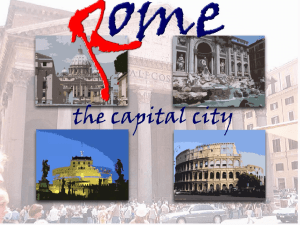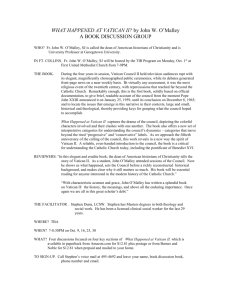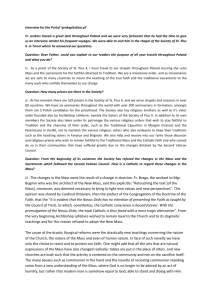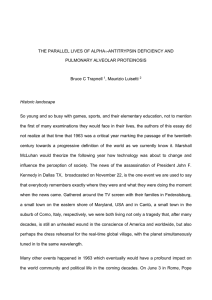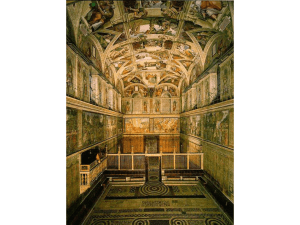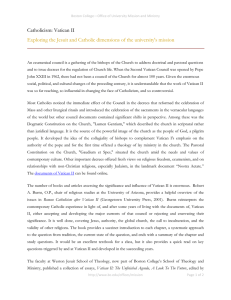P l e a s e P r... T 28 S
advertisement
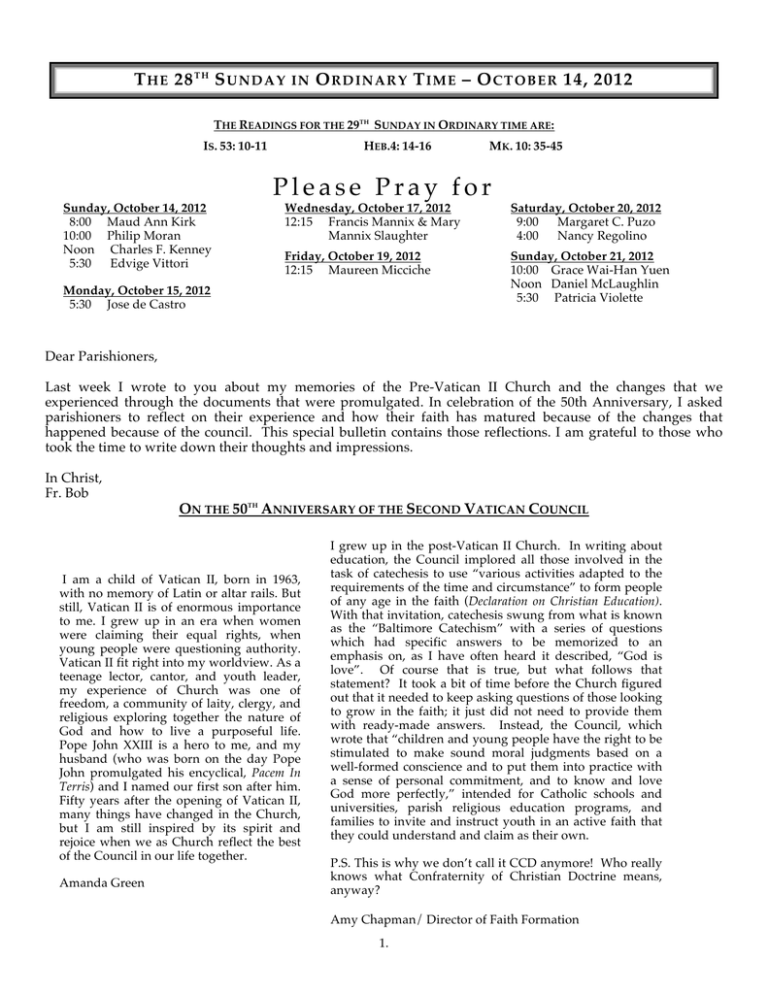
T H E 28 T H S U N D A Y IN O R D IN A R Y T IM E – O C T O B E R 14, 2012 THE READINGS FOR THE 29TH SUNDAY IN ORDINARY TIME ARE: IS. 53: 10-11 Sunday, October 14, 2012 8:00 Maud Ann Kirk 10:00 Philip Moran Noon Charles F. Kenney 5:30 Edvige Vittori HEB.4: 14-16 MK. 10: 35-45 Please Pray for Wednesday, October 17, 2012 12:15 Francis Mannix & Mary Mannix Slaughter Saturday, October 20, 2012 9:00 Margaret C. Puzo 4:00 Nancy Regolino Friday, October 19, 2012 12:15 Maureen Micciche Sunday, October 21, 2012 10:00 Grace Wai-Han Yuen Noon Daniel McLaughlin 5:30 Patricia Violette Monday, October 15, 2012 5:30 Jose de Castro Dear Parishioners, Last week I wrote to you about my memories of the Pre-Vatican II Church and the changes that we experienced through the documents that were promulgated. In celebration of the 50th Anniversary, I asked parishioners to reflect on their experience and how their faith has matured because of the changes that happened because of the council. This special bulletin contains those reflections. I am grateful to those who took the time to write down their thoughts and impressions. In Christ, Fr. Bob ON THE 50TH ANNIVERSARY OF THE SECOND VATICAN COUNCIL I am a child of Vatican II, born in 1963, with no memory of Latin or altar rails. But still, Vatican II is of enormous importance to me. I grew up in an era when women were claiming their equal rights, when young people were questioning authority. Vatican II fit right into my worldview. As a teenage lector, cantor, and youth leader, my experience of Church was one of freedom, a community of laity, clergy, and religious exploring together the nature of God and how to live a purposeful life. Pope John XXIII is a hero to me, and my husband (who was born on the day Pope John promulgated his encyclical, Pacem In Terris) and I named our first son after him. Fifty years after the opening of Vatican II, many things have changed in the Church, but I am still inspired by its spirit and rejoice when we as Church reflect the best of the Council in our life together. Amanda Green I grew up in the post-Vatican II Church. In writing about education, the Council implored all those involved in the task of catechesis to use “various activities adapted to the requirements of the time and circumstance” to form people of any age in the faith (Declaration on Christian Education). With that invitation, catechesis swung from what is known as the “Baltimore Catechism” with a series of questions which had specific answers to be memorized to an emphasis on, as I have often heard it described, “God is love”. Of course that is true, but what follows that statement? It took a bit of time before the Church figured out that it needed to keep asking questions of those looking to grow in the faith; it just did not need to provide them with ready-made answers. Instead, the Council, which wrote that “children and young people have the right to be stimulated to make sound moral judgments based on a well-formed conscience and to put them into practice with a sense of personal commitment, and to know and love God more perfectly,” intended for Catholic schools and universities, parish religious education programs, and families to invite and instruct youth in an active faith that they could understand and claim as their own. P.S. This is why we don’t call it CCD anymore! Who really knows what Confraternity of Christian Doctrine means, anyway? Amy Chapman/ Director of Faith Formation 1. 1962 was the time of a lifetime to be a Catholic. John Kennedy was President; Cardinal Cushing was the most positively influential person in Massachusetts; and the beloved, humble John XXIII was determined to change the face of the Church. His great Ecumenical Council opened our Church to the modern world, embraced other Christian traditions and Judaism, and understood that God really acts solely from love and is not the distant, unapproachable, demanding, and punishing God we had been raised with. Even more, the Council acknowledged that all of the people of God are the Church. And while our bishops have still to embrace and implement this fundamental insight– first declared by Paul within years of the Resurrection– the promise of Vatican II is lived in our vibrant, St. Ignatius Parish community. Here, all of us, parishioners, religious, and our Jesuit brothers alike, know that together we are the Church. I was born the year before the Second Vatican Council opened. So, trying to explain the impact the Council and its teachings have had on my faith is a bit like trying to describe the influence oxygen has had on my life: It's simply been the air my generation of Catholics has breathed: You see, just as folks my age began figuring out some of what it meant to be alive, the Church Herself seemed to burst to life--re-examining and re-imagining what (and who) was really involved in being the true sign of Christ in the world. In many ways, I feel like I grew up with as well as in the Church, going through my own growing pains and changes and periods of confusion and grace, along with Hers. And you know what? It was never dull. Even a bad guitar Mass was its own kind of adventure. As for all that V2 ecclesiology? The Church as the People of God? The People as the living Body of Christ? That all became undeniably, indelibly real to me. As real as the Body and Blood of our Lord Jesus Christ raised up on the altar. And we have Vatican II to thank for that, too. /Anne Murphy /Ed Dailey The most significant aspect of Vatican II for me was my ability to move from a spirituality of ‘doing’ to a spirituality of ‘Being’. My pre-Vatican 2 religious life was circumscribed by two pervasive precepts: thou shalt and thou shalt not. Like many other Catholics of the time, I had a sense that by strictly adhering to the Church’s dogma, doctrine, and ritual and the directives of the hierarchy that this ’doing’ would somehow be pleasing God. In some unarticulated way this adherence would also result in a greater guarantee of salvation. As the Spirit of Vatican II began to seep into my bones and intellect, I came to a profound realization that God loves me as I am. This realization of being a Being created out of Love and sustained in Love has been profoundly liberating for me spiritually. It has enabled me to develop an intimate relationship with Jesus the Christ and a deeper understanding of my Baptismal role within the Church. Just old enough to be aware of the Council as it was going on, I knew the excitement of the renewed liturgy, of becoming a fully engaged participant at Mass, not a mere observer. With time, however, I've come to think that the most significant and enduring change the Council brought was the redefinition of the Church as the People of God. This fundamentally democratic (small d) imagery recognizes the role of all believers and has sustained a commitment that might not have been possible otherwise. The leaders and institutions of the Church will come and go, as they have throughout history, but God's People will persevere in their efforts to live the Christian life. /James M. O'Toole Clough Chair in History, Boston College /Richard Moynihan/ Parish Business Manager This 50th Anniversary of the opening of the Second Vatican Council coincides with the 50 years dating from my First Profession as an fmsa. One of my greatest and deepest joys was in the hope of 'opening' windows and doors previously closed to the ordinary people of God, myself included in the category of 'laity.’ In those days I still held as positive 'expectations'. I have since learned that "expectations are the construction of resentment"! My attitude however moves to DESIRE resulting from my experience of amazing collaboration between the Divine Collaborator and the rest of us. This has opened doors and windows in my own life that continue to unfold in JOY and GRATITUDE. As a result of the Document on Religious Life, and the emphasis on one's Commitment as an 'unfolding' (my own way of experiencing this...) of one's Baptismal Commitment, I returned to my Baptismal 'name' and changed my annual Feast Day to the date of my Baptism. This has brought a whole new dimension and link to my living as a member of the Laity, now more actively involved in the Life of the church. /Sr Anne Schoettlekotte fsm 2. On November 29, the First Sunday of Advent 1964, the liturgical changes of Vatican 2 began to be implemented in parishes throughout the world. For those of a certain age who experienced these momentous liturgical times, many aspects of the Mass were drastically changed - much more so than we experienced this past Advent with the new Missal translation. The orientation of the priest, the enriched, expanded Liturgy of the Word, and, most strikingly, the introduction of the vernacular language to the Mass were pivotal for worshipping Catholics. The music for liturgy transitioned from a body of Latin chants and dialogs, devotional hymns, and sentimental melodies to a repertoire of scriptural-based songs, responses and acclamations in English, and a range of musical styles from soup to nuts. The enduring bullet point from Vatican II for music and liturgy is "full, conscious and active participation by all the faithful". In the almost five decades since The Constitution on the Sacred Liturgy, many of the early attempts for musical implementation of Vatican 2 are faded and forgotten; but still we strive, almost 50 years later, to realize the intentions of the Holy Spirit and be nourished by the fruits of Vatican II /Michael Burgo/ Parish Music Director Like Fr. Bob, I too was a teen when Pope John XXIII opened the Second Vatican Council in October 1962. I studied the documents as they came out "hot off the press" as it were. The dead language of Latin became suddenly alive as students spoke with excitement of Lumen Gentium and Gaudium et Spes. The Pope was throwing open the windows of the church, bringing in fresh air, and we breathed it deeply. Having read the decree on the Apostolate of the Laity, I found myself driving with other students to Kansas City for training in the Lay Apostolate. Needless to say, my classmates and I embraced the Council reforms and all the changes that ensued, but the most critical change in me was in my thinking. From that time on I've had a view of the church not as a building, nor the hierarchy, but as the people of God!! Mary Supple Dailey I had just turned four years old when the Vatican II Council made its debut in 1962. As a child, my earliest and rather humorous recollection attending church was wondering how possibly God could fit in a beautiful gold box? Seemingly, to me, I imagined God as a man of average height. Fortunately, in time, and with age I was able to ponder the beautiful mysteries of the Eucharist and its home in the Tabernacle. As I reminisce, perhaps my early childhood memory could stand as one of many metaphors for what was to come for me as a Catholic, for the Church and its people in the next fifty years. Over these years, others and I have witnessed the many transformations that the church has made – covering much holy ground near and far sometimes on very bumpy roads and making unfortunate detours. There are many questions and many mysteries indeed. As I attend church today, it is very visible and clear that God truly does not live in a box. Rather, He and She are of many varieties including height. God lives in the people. As a woman in my parish, I am very grateful to know I can serve as a body of the church in several ministries. As a church, we have come a long way. Let us be hopeful for what the next fifty years can Robin Dawkins From my limited engagement with preVatican II, two of the most talked about subjects I have heard people comment on over the years have been the joy of being "allowed" to focus on scripture, and, the joy of partaking in a much deeper development of spirituality, especially in a person's intimate relationship with Jesus. Christopher Duffy, S.J. "It is for freedom that Christ has set us free.". (Gal 5.1) St. Paul must be rejoicing with us. The freedom which he celebrated 2000 years ago received a fresh breath of air in our own time. That is the one word the Council honors so consistently. Freedom for us all to claim our rightful place as People of God--the baptized no less than the ordained. Freedom to open and treasure the Word of God as perhaps never before. Freedom to worship in a style and language accessible to all. Freedom to embrace in friendship and respect our ancestors in faith, the Jewish people. Freedom to join hands and hearts with our fellow Christians in belief, if not yet in full communion. Freedom to celebrate conscience as the cornerstone of it all. They were days to rejoice! They still are! They must be! JA Loftus, S.J. 3. With the implementation of changes resulting from the Second Vatican Council, three images come to mind from my childhood. First, we no longer had to pull out from the glove box the wrinkled mantillas in their plastic cases and secure them to our heads with bobby pins. Secondly, the nuns now dressed like my grandmothers. Thirdly, the priest and altar were turned around. Though I was just at the age of reasoning, the theology was lost on me but the pedagogy was not. It was this “turning around” and “turning toward” that signified to me something had changed. We were no longer observers to, but participants in. Being face to face during this most sacred celebration of the church embodied a sense of vulnerability, humanness and personal relationship that extended beyond just me, the priest and the people in my church but out into the whole world as well. It is not surprising that as I grew in faith Gaudium et Spes was the pastoral constitution I gravitated towards, resonate with, and am still challenged to embody today. Vatican II was a happening for my wife Eileen and I.We had just graduated from BC and had decided to get married. Jack Corazzini, my wife's brother,was finishing his studies at the North American College in Rome. Jack was relaying all the week to week news and excitement of Vatican II to our families. He and his classmates were on fire with the Holy Spirit and we could feel it. It was a spiritual happening and you could feel the Holy Spirit opening the windows to our Church and letting the fresh air in. Unfortunatly,when the "Romans "came back to serve the American Church many were "stiffarmed" by their new pastors and within two years left the priesthood, including Fr.Jack Corazzini. The windows were quickly closed, if they were ever actually opened in the US. We are in awe of Pope John XXIII and have no doubt we are way overdue for the Holy Spirit to re-open the windows of the Church. Our parish is like a light shining through an open window from Vatican II--/Frank and Eileen Faggiano As is true in so many events in life, time plays a significant role in how we integrate not only how we have been impacted, but how we have also changed as a result of what has taken place. Vatican II has been one of those “events”, and the 50 years since the opening of the Council has made me appreciate the meaning of “We are the Church”. I was 8 when the Council opened, so my growing up was parallel to the Church growing as well. Many changes took place in the years that followed, and I even remember the Monday morning when the nuns arrived wearing very different habits from what we saw them wearing on Friday! What I’ve learned about my faith is that it is a matter of a very personal commitment, not merely an obligation, and clearly not just something you are born into. Faith is also about what we do in terms of taking care of each other, not merely as a theory but a reality. Vatican II has challenged me to not be complacent, but to instead take responsibility for becoming the best Catholic I can be. /Susan L. Stuart Associate Director of Faith Formation Though Vatican II opened a few years before I was born, it took time to be felt in all the parishes. I remember the "communion rail" as I call it, separating the sanctuary from the pews. More aptly put, it separated the priest from "the rest of us". The rails are now gone from the small church I attended as a little girl, but whenever I go to Mass there with my mother I can shut my eyes and picture them. I hope that in the coming years we continue to respect and recognize the important role of Priest and also the important role that we as co-celebrants have, not only in the Mass but as one, active faith community. /Amy Larson Charles Martel My wife and I welcomed the announcement of PopeJohn's announcement of Vatican II. In 1962 we were in our late thirties with six of our seven children born. Although we didn't know of what would happen, his expression of risorgiamento rang in our hearts. The idea of opening the windows of the Church and letting in " l'aria fresca " (the fresh air) of the Church was refreshing and hopeful. Those hopes were fulfilled by the Council. Initially it meant that, for us, the celebration of the Eucharist, Catholic's would no longer be merely attendees but now participants - the first expression that Catholics could now say prayerfully that "We are the Church". The Eucharist was celebrated in English and the celebrant faced the people. Our prayer life was changed also, seeing God in a different light from the judging God to the ever present loving God. There was also the effect it had on the priests that we knew who felt free from the many of the constraints of the past. Imagine,you could now invite a priest to your home for a dinner! Those first years, where there was an overindulgence in some of the practices, I could never be excited over the Kumbaya, Michael Row the Boat Ashore "hymns" or Bond bread substituted for the Eucharist. but those were minor compared to the full import of impact on our family's religious lives. Despite the fact that there seems to be a movement for a rollback - a moving forward by going backwards, we are confident that the Church can never return to pre-Vatican II times. Joe DiNatale 4. CHURCH OF SAINT IGNATIUS OF LOYOLA 28 COMMONWEALTH AVENUE – CHESTNUT HILL, MA 02467 PHONE 617-552-6100 FAX: 617-552-6101 E-MAIL IGNATIUS@BC.EDU WEB: HTTP://BC.EDU/ST-IGNATIUS THE PARISH STAFF REV. ROBERT F. VER EECKE, SJ, PASTOR REV. KENNETH G. LOFTUS, SJ, ASSOCIATE REV. JOHN ALLAN LOFTUS, SJ, ASSOCIATE CAP TEAM MEMBER (CHAIR) MICHAEL BURGO, DIR. OF MUSIC MINISTRY TIMOTHY ZIMMERMAN, ASSOCIATE DIR. OF MUSIC / ORGANIST SR. DIANE VALLERIO, MFIC, DIR. OF OUTREACH AMY CHAPMAN, FAITH FORMATION DIRECTOR SUSAN STUART, ASSOC. DIR. FAITH FORMATION DANIEL ROBB, CORD. FAITH FORMATION RICHARD MOYNIHAN, BUSINESS MANAGER ELIZABETH MCLAUGHLIN, ADM. ASSISTANT WALTER FOTHERGILL, FACILITIES MANAGER 617-552-6107 617-552-6103 617-552-6105 DANIEL.ROBB@BC.EDU 617-552-6112 MOYNIHAR@BC.EDU 617-552-6117 IGNATIUS@BC.EDU 617-552-6102 WALTER.FOTHERGILL @BC.EDU 617-552-6119 KATHY MAHER MARC GERVAIS MARY SANTAPAULA KSULLIVAN-MAHER@MILTONPS.ORG MIG@GERVAISDAVENPORT.COM MSANTAPAULA@RCN.COM CAP TEAM MEMBER CAP TEAM MEMBER CAP TEAM MEMBER FRVEREEC@BC.EDU LOFTUSKE@BC.EDU JA.LOFTUS@BC.EDU 617-552-6100 617-552-6100 617-552-6100 BURGO@BC.EDU ZIMMERTA@BC.EDU 617-552-6108 617-552-6114 VALLERIO@BC.EDU CHAPMAAB@BC.EDU LANGINST@BC.EDU THE CELEBRATION OF EUCHARIST SUNDAY WEEKDAY SATURDAY UPPER CHURCH 8:00 AM, 10:00 AM, 12:00 NOON, 5:30 PM LOWER CHURCH 8:00 AM, 10:00 AM, FAMILY LITURGY 12:00 MISA EN ESPAÑOL EN LA CAPILLA LANNON 12:15 PM - 5:30 PM – LOWER CHURCH LOWER CHURCH 9:00 AM, UPPER CHURCH 4:00 PM (Vigil) THE SACRAMENTS BAPTISM Adults are baptized at the Easter Vigil as part of the Rites of Christian Initiation for Adults. Infant and child baptisms are by arrangement. FIRST EUCHARIST Preparation begins in Grade 1 and includes classes, retreats and home instruction. CONFIRMATION Our Confirmation program begins in the 9th grade. Students are confirmed in the Spring of the 10th grade. Young adults who have been catechized but are not yet confirmed should contact the Parish Office for an alternative program. MATRIMONY Must be registered as a parishioner six months prior to beginning Marriage arrangements. RECONCILIATION Saturdays 3:15 – 3:45 PM Upper Church or by arrangement ANOINTING OF THE SICK by arrangement. 5.
